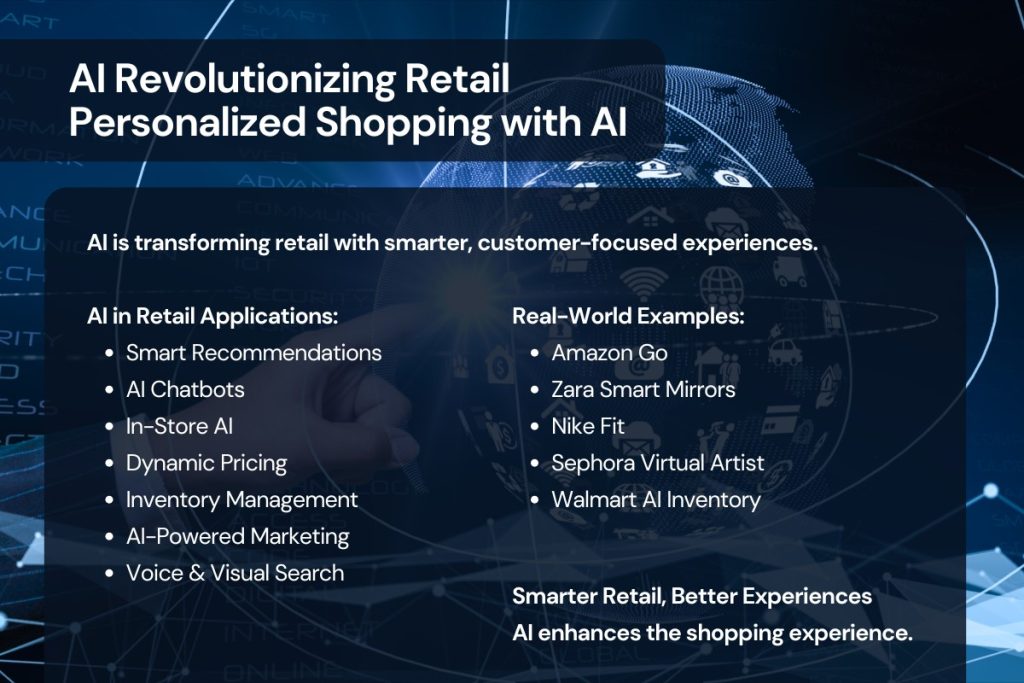The potential of AI in retail is driving a massive transformation of the retail industry. Conventional shopping practices are being upgraded with AI-based retail experiences, which are becoming more efficient, immersive, and customer-focused. Ranging from customized product suggestions to AI-based virtual assistants, shopping artificial intelligence is revolutionizing how consumers engage with brands and shop.
Let’s explore how AI is transforming retail with personalized shopping:
1. AI-Powered Product Recommendations
The most powerful application of ai in retail
technology is product recommendation based on individual tastes. E-commerce sites such as Amazon and top fashion stores use AI to evaluate customer browsing history, previous purchases, and interests. This information enables companies to suggest products that best match the tastes of individuals, increasing conversions and customer satisfaction.
2. AI Chatbots & Virtual Shopping Assistants
AI chatbots and virtual assistants are transforming personal shopping with instant customer service. They are helping the customer in finding the right item, answering his or her inquiries, and making the purchasing process simpler. AI-powered chatbots are modeled after human communication, engaging consumers in productive and timely responses.
3. AI-Optimized In-Store Experiences
Physical stores are also capitalizing on ai in retail
to maximize in-store interaction. Smart mirrors enable customers to virtually test clothing, and AI-powered checkout-free stores provide effortless transactions. Retailers employ AI-enabled insights to analyze foot traffic patterns and streamline store layouts for a more efficient shopping process.
4. AI-Driven Pricing & Promotions
Dynamic pricing is yet another important area of AI in retail. The best prices are determined by AI by analyzing market trends, competitor prices, and customer demand. This helps businesses provide competitive price strategies and targeted discounts that raise customer retention and revenue.
5. AI in Inventory Management
AI plays a vital function in inventory optimization by forecasting demand patterns and sustaining optimal stock quantities. This averts overstocking and shortage of products, making customers get what they seek while reducing loss for retailers.
6. AI-Powered Marketing Campaigns
Retailers develop highly targeted marketing campaigns using analytics driven by AI. AI analyzes consumer behavior, buying patterns, and online activity to make sure marketing messages are delivered to the right people at the right moment, boosting engagement and conversion rates.
7. Voice & Visual Search Technology
Voice assistants such as Alexa and Google Assistant are transforming artificial intelligence in retailing through voice searches for products. Also, visual search powered by ai in retail
enables customers to upload a picture to locate similar products, simplifying and making shopping easier.
Real-World Retail Examples of AI
- Amazon Go: Amazon’s cashless stores employ AI-powered cameras and sensors to monitor items, allowing checkout to be effortless.
- Zara’s Intelligent Mirrors: Zara introduced AI-driven intelligent mirrors in a few stores to enable customers to try on clothing virtually.
- Nike Fit: Nike’s AI-enabled solution uses the customer’s foot scan through an app to suggest the ideal shoe size, boosting comfort and returns.
- Sephora Virtual Artist: Sephora employs AI to enable customers to try on makeup virtually prior to buying to enhance the shopping experience for beauty.
- Walmart’s AI-Optimized Inventory: Walmart uses AI to track inventory in real-time, avoiding stockouts and maintaining product availability.

The Future of AI in Retail
As AI continues to advance, personalized shopping in the future will become increasingly innovative. Retailers embracing AI-driven retailing will have a competitive edge by providing frictionless, hyper-personalized experiences. Future development could involve predictive analytics, emotion-based AI personalization, and increased automation in physical stores. Having AI integrated into the retail industry is no longer a choice—it’s a must for companies to succeed in an increasingly changing world.
Conclusion
AI is basically revolutionizing the retail industry by providing personalized shopping experiences, enhancing operational effectiveness, and facilitating smarter decision-making. As ai in retail
technology advances, its contribution to the retail sector will continue to grow, making shopping easier, more intelligent, and more customer-focused. Companies that adopt retail AI technology now will dominate the future of trade, offering an integrated and customized experience for customers.
FAQ
1. In what ways does AI improve the shopping experience in retail?
AI improves the shopping experience through personalized suggestions, self-service checkouts, and virtual assistants to help customers.
2. What are practical uses of AI in retail?
Amazon Go, Nike Fit, and Sephora Virtual Artist use AI to provide better personalization and streamline operations.
3. How does AI enhance inventory management?
AI forecasts demand, tracks inventory levels in real-time, and avoids overstocking and stockouts.
4. Will AI displace human workers in retail?
AI replaces repetitive work, but human workers are still needed for customer service and sophisticated decision-making.
5. How do AI-based pricing strategies function?
AI considers customer behavior, competitor prices, and demand patterns to dynamically optimize product prices.
6. Are AI-based product recommendations effective?
Yes, AI learns from customer interactions and updates recommendations to increase accuracy over time.
7. What is the future of AI in retail?
Future developments are made up of greater personalization, customer insight through AI, cashier-less stores, and more automation to enhance efficiency.

Leave a Reply